Types of Cheese You Can Put on Pizza
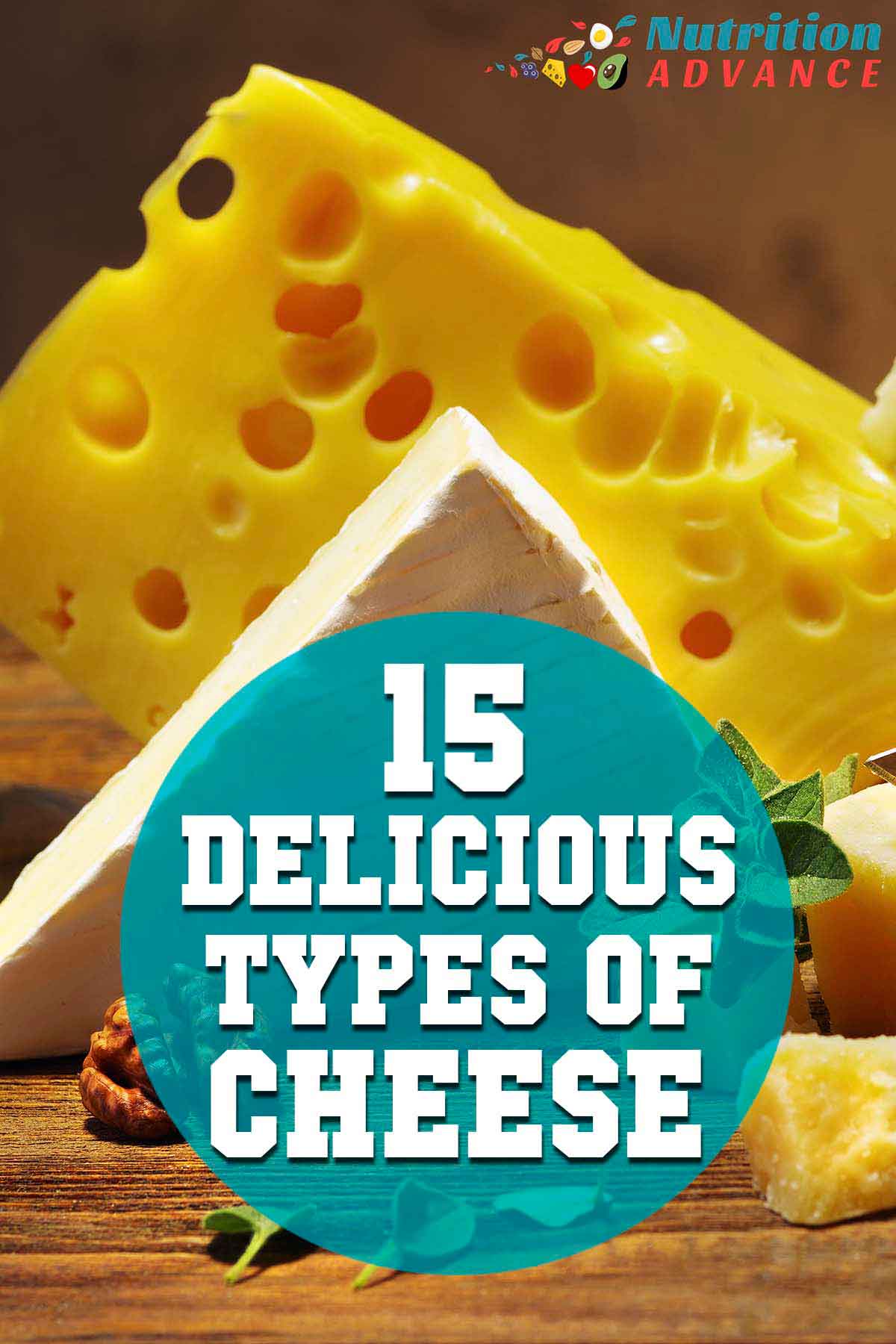
Last Updated on June 18, 2021 by
 Cheese is a delicious type of dairy food and it plays a key part in almost every cuisine in the world.
Cheese is a delicious type of dairy food and it plays a key part in almost every cuisine in the world.
While everyone has their personal favorite, some people like to discover new varieties of cheese.
This article will present a list of delicious cheeses from around the world, alongside their main characteristics and basic nutritional information.
All nutrition data is per 100g and sourced from the USDA FoodData Central Database.
1. American Cheese
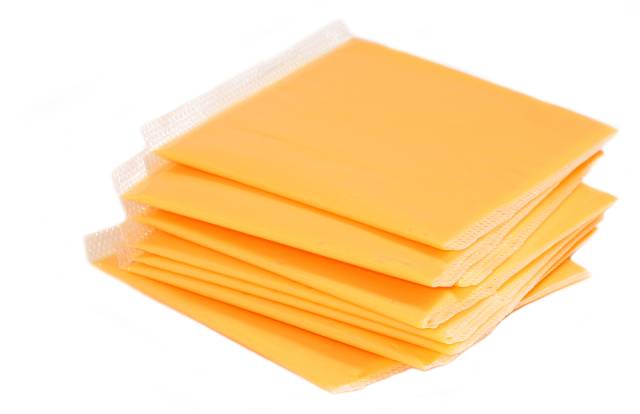
- Country of Origin: United States
- Strength: Mild
- Texture: Soft, smooth, and creamy
- Appearance: Light orange to pale yellow
- Calories: 307 kcal
- Carbohydrate: 8.9 g
- Fat: 23.1 g
- Protein: 16.1 g
American cheese' is a type of cheese that almost everybody knows.
This cheese is also sometimes known as 'slice cheese' or 'processed cheese' and it is a mix of cheese with additional ingredients such as whey, milk powder, and butter.
While the exact cheese used to make American cheese can vary, it is common to use a mild Cheddar or cheese with similar characteristics.
This cheese has a mild taste, a kind of stretchy feel, and it melts easily. We can find it in cheeseburgers around the world.
Key Point: American cheese is an extremely popular processed cheese product, and it is a common ingredient in cheeseburgers.
2. Brie
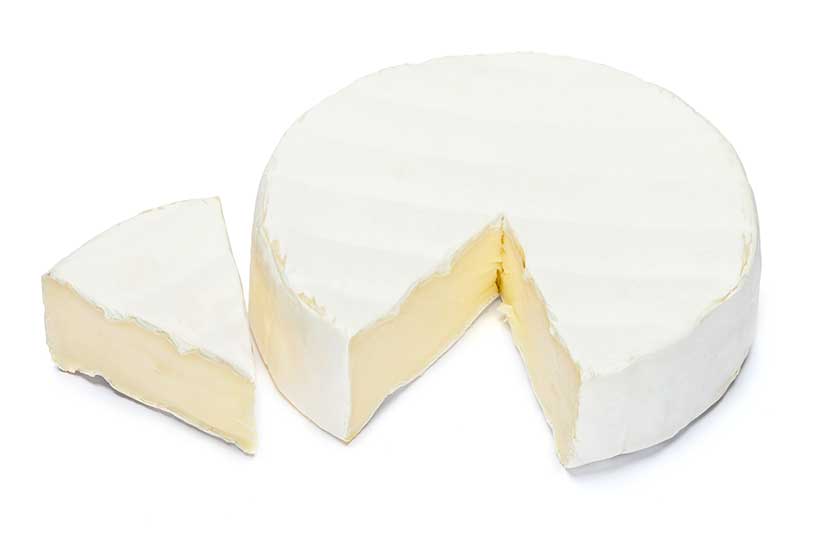
- Country of Origin: France
- Strength: Generally mild
- Texture: Soft, creamy
- Appearance: Pale yellow, white rind
- Calories: 334 kcal
- Carbohydrate: 0.5 g
- Fat: 27.7 g
- Protein: 20.7 g
Brie is a soft and creamy cheese from the region of Brie in Northern France.
The cheese has a delicious soft center surrounded by a slightly chewy rind. Brie is much milder and creamier in flavor than its cousin Camembert, and this is down to two things.
First, producers add cream to Brie before fermentation, and this gives the cheese a higher fat content.
Secondly, much smaller amounts of bacterial cultures (lactic acid) are added to Brie, giving it a lighter flavor.
Brie is one of the most popular cheeses in the world, and it pairs well with cured ham, fruits, and wine on a cheese board.
Additionally, various recipes that involve baking Brie are becoming increasingly popular.
Key Point:Brie is a deliciously creamy, high-fat cheese with a soft and mild flavor.
3. Camembert
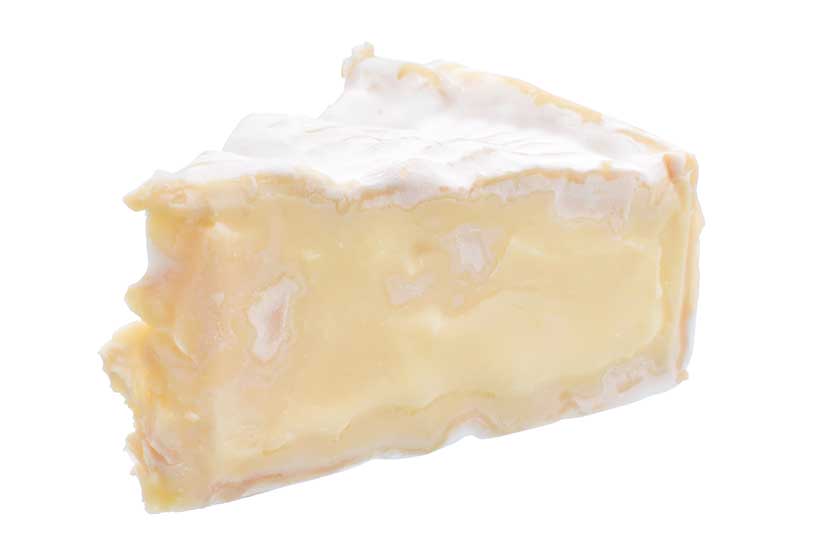
- Country of Origin: France
- Strength: Medium, pungent
- Texture: Soft, creamy
- Appearance: Pale yellow, white rind
- Calories: 300 kcal
- Carbohydrate: 0.5 g
- Fat: 24.3 g
- Protein: 19.8 g
One of the most famous cheese names in the world is Camembert.
Similar to Brie, this cheese's origins lie in Northern France. The cheese is named after the town of Camembert, situated in the Normandy region of France.
Camembert and Brie may look the same, and although Camembert is less creamy, it makes up for this by turning up the flavor dials.
For one thing, Camembert is ripened/fermented in smaller sizes, which allows for a faster process. This process means that Camembert will age quicker (and be more pungent) than an equivalent-aged Brie.
The flavor of the two is similar, but Camembert has a stronger and deeper taste. It is much more flavorful, and sometimes it can have slightly sour notes
Camembert also has a much stronger smell, which puts some people off.
Key Point: Camembert shares many traits with Brie, but it has a stronger flavor.
4. Cheddar
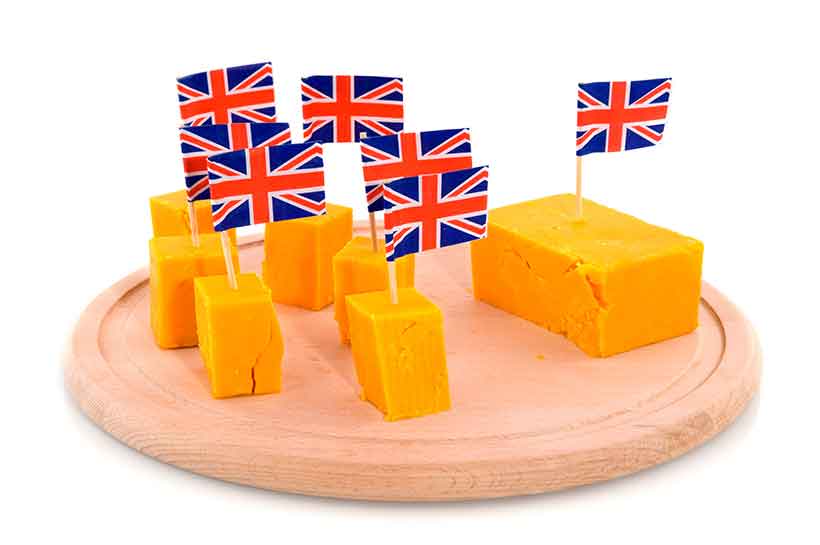
- Country of Origin: England
- Strength: Mild to pungent
- Texture: Soft and smooth to crumbly
- Appearance: Pale white to orange
- Calories: 403 kcal
- Carbohydrate: 1.3 g
- Fat: 33.1 g
- Protein: 24.9 g
Possibly the most famous variety of cheese, Cheddar comes from the village of Cheddar in Somerset, England.
There are all different kinds of Cheddar, and the cheese comes in many different strengths.
According to the British Cheese Board, these different strengths of Cheddar depend on how long the cheese was aged;
- Mild: 3 months
- Medium: 5-6 months
- Mature: 9 months
- Extra Mature: 15 months
- Vintage: 18 months or older
Mild cheddar has a soft and smooth texture, and a light and almost creamy flavor.
On the other hand, vintage cheddar is hard and crumbly and has a powerful, sharp, and tangy flavor. It may also develop crunchy cheese crystals, these crystals are a result of protein breaking down, but they taste delicious.
Key Point:Cheddar can range from mild in flavor to a sharp and powerful cheese. It is possibly the world's most recognizable cheese.
5. Cottage Cheese
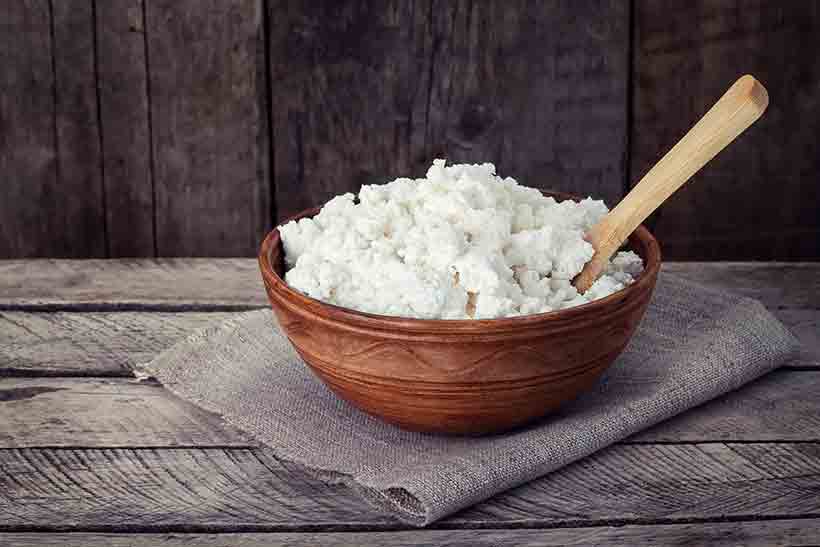
- Country of Origin: United States
- Strength: Mild
- Texture: Moist and creamy
- Appearance: White curds
- Calories: 98 kcal
- Carbohydrate: 3.4 g
- Fat: 4.3 g
- Protein: 11.1 g
Cottage cheese is very different from most other varieties, and its closest relation is probably ricotta.
This famous cheese is made by acidifying curds from milk with a bacterial starter culture.
Due to the different production process, the nutrition profile is very different from other types of cheese. It has a very low fat content and is therefore much lower in calories.
As a result, cottage cheese is particularly useful for those wanting a more protein-dense option.
On the negative side, some people find the appearance of cottage cheese off-putting. They may have a point because the lumpy texture somewhat resembles cold rice pudding.
However, it does taste good, and it has a mild, salty, and creamy taste.
We can also use it in various recipes, such as these delicious cottage cheese pancakes.
Key Point:Cottage cheese is a popular type of cheese, especially in the UK and United States. It is full of protein and very nutrient-dense.
6. Cream Cheese
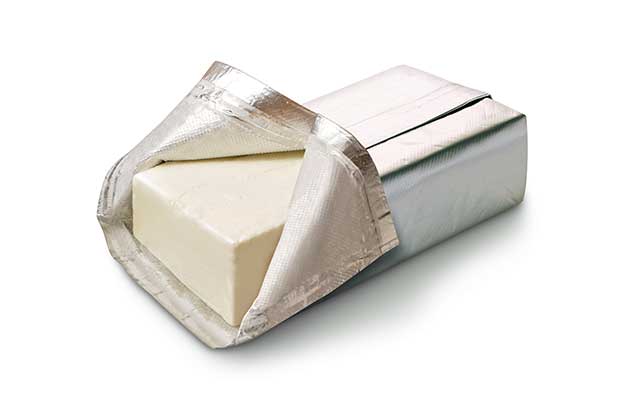
- Country of Origin: United Kingdom
- Strength: Mild, slightly sweet
- Texture: Soft and creamy
- Appearance: White spread
- Calories: 342 kcal
- Carbohydrate: 4.1 g
- Fat: 34.2 g
- Protein: 5.9 g
Although cream cheese may seem like a more recent cheese product, it actually has hundreds of years of history.
The first known mentions of the cheese go back to 1583, making cream cheese almost 500 years old.
Cream cheese comes in all different varieties and flavors, and it tastes delicious either plain or with additional seasonings like garlic and chives.
Nutritionally, cream cheese is quite a lot different to hard and semi-hard types of cheese. It has a much higher fat content and less protein.
For more information and some recipe ideas, see this guide to cream cheese.
Key Point:Cream cheese is a delicious, soft cheese spread which is naturally very high in fat.
7. Epoisses
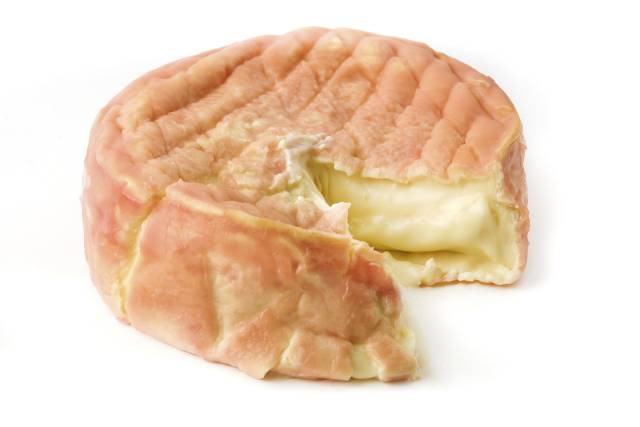
- Country of Origin: France
- Strength: Strong, pungent
- Texture: Cream-colored
- Appearance: White flesh and bronzed orange rind
- Calories: 296 kcal
- Carbohydrate: 0.7 g
- Fat: 25.1 g
- Protein: 16.9 g
Epoisses is an extremely flavorful French cheese that also has an extremely strong smell.
The cheese is a washed-rind cheese that looks slightly similar to brie and camembert, but it has a darker orange-colored rind.
As well as being flavorful, the cheese is very soft and creamy.
Most produced Epoisses cheese is unpasteurized. However, due to food safety laws, only pasteurized versions of Epoisses are sold in the United States.
Key Point:Epoisses is a popular cheese variety with a powerful taste.
8. Feta Cheese
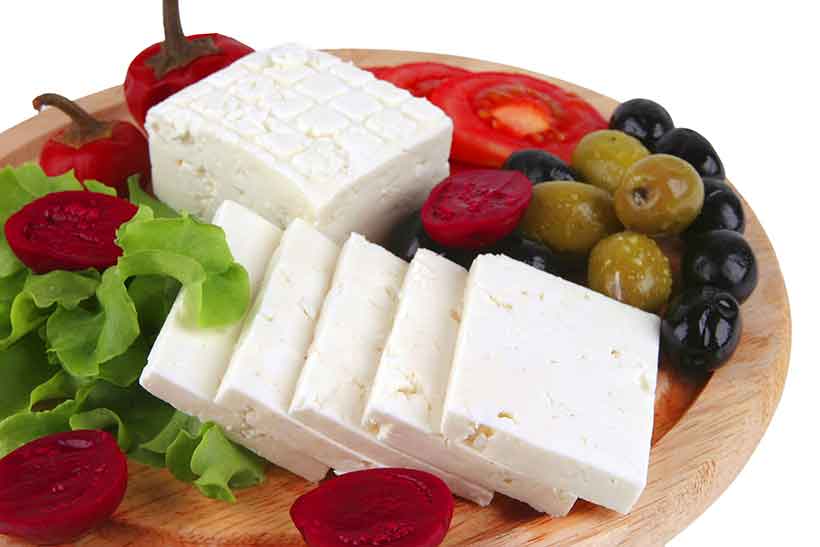
- Country of Origin: Greece
- Strength: Mild
- Texture: Creamy to crumbly
- Appearance: Pale, white curd
- Calories: 264 kcal
- Carbohydrate: 4.1 g
- Fat: 21.3 g
- Protein: 14.2 g
Feta is a famous Greek kind of cheese made from either sheep or sheep and goat's milk.
Unlike many other kinds of cheese, it is not named after the place where it first originated, and "Feta" actually means "slice" in English.
Feta has quite a unique taste, and it is very soft and creamy with a salty and tangy taste. However, the flavor can vary greatly depending on how it is prepared or cooked.
For instance, there is a wide variety of ways to serve Feta; it can be grilled, eaten raw in a salad, or marinated in olive oil and several herbs.
Feta cheese has a couple of specific health benefits too;
- Since Feta uses sheep or goat's milk, it may be suitable for those who havesensitivities to cow's milk.
- Feta is lower in fat and calories than hard forms of cheese, despite also offering an impressive range of nutrients. As a result, it is very nutrient-dense.
Feta is available either in a block or in "crumbled" form, and it is usually packed in a brine solution.
Key Point:Feta is a highly nutritious cheese made from pastured sheep and goat's milk.
9. Gorgonzola
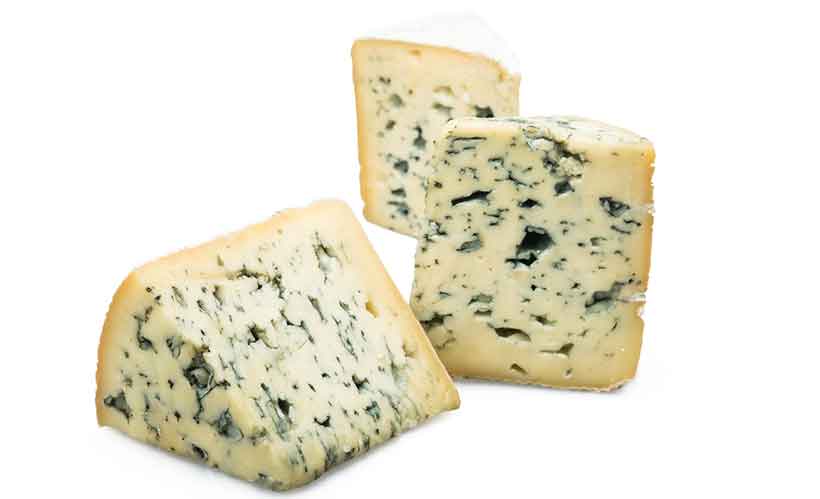
- Country of Origin: Italy
- Strength: Sharp, strong
- Texture: Creamy to crumbly
- Appearance: Pale yellow, white skin
- Calories: 353 kcal
- Carbohydrate: 2.3 g
- Fat: 28.7 g
- Protein: 21.4 g
Gorgonzola is a strong and powerful cheese from Italy that packs a big flavor.
There are two main varieties of this cheese; Dolce and Piccante.
Typically aged for less than three months, Dolce Gorgonzola is a very soft, creamy, and almost spreadable cheese.
For blue cheese, it is also quite mild and has a slightly sweet flavor. However, the key words there are "for a blue cheese" – it is still sharp and pungent compared to other cheeses.
On the other hand, Piccante Gorgonzola ages for between six and twelve months, and the extra aging time is apparent when you first taste it.
The texture is semi-hard and crumbly, and the flavor is intensely pungent. For this reason, it is better paired with food rather than eaten alone.
Key Point:Gorgonzola is one of the more intense cheese varieties, and it packs a punch in the flavor department.
10. Gouda

- Country of Origin: Netherlands
- Strength: Mild to strong
- Texture: Semi-hard to hard
- Appearance: Light to dark yellow
- Calories: 356 kcal
- Carbohydrate: 2.2 g
- Fat: 27.4 g
- Protein: 24.9 g
Gouda is a Dutch cheese from the town of Gouda in the Southern Netherlands.
Interestingly, the taste, texture, and flavor of Gouda can vary a lot.
Due to the extensive differences in aging time (anywhere from 1 month to 36 months), two different types of Gouda can taste entirely different.
Younger cheeses are mild in flavor with a smooth, semi-hard texture; older Gouda is hard and crumbly, with a deeper flavor.
Similar to Cheddar, Dutch cheesemakers classify Gouda by six different grades, depending on the age;
- Young cheese: 4 weeks
- Young matured: 8-10 weeks
- Matured: 16-18 weeks
- Extra matured: 7-8 months
- Old cheese: 10-12 months
- Very old cheese: 12 months +
Key Point:Gouda comes from the Netherlands and it is one of the most popular cheeses in the world.
11. Gruyère
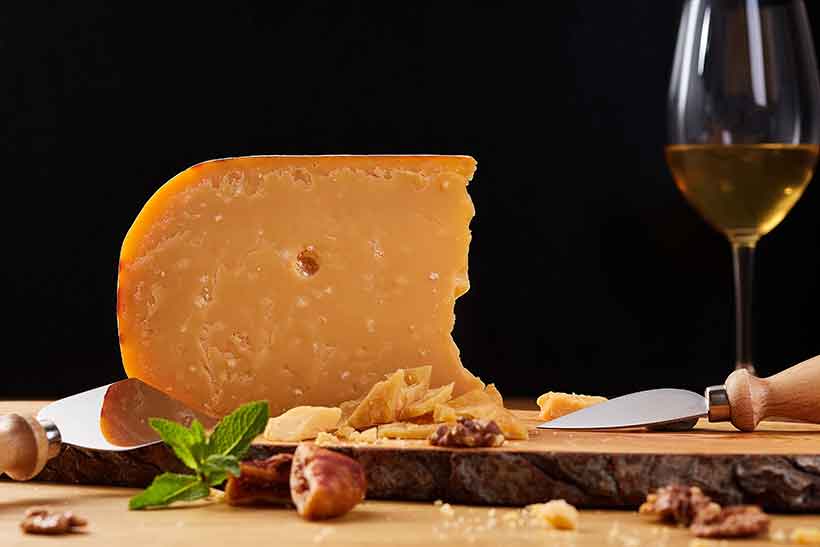
- Country of Origin: Switzerland
- Strength: Mild to strong
- Texture: Hard, firm, dense
- Appearance: Cream to orange
- Calories: 413 kcal
- Carbohydrate: 0.4 g
- Fat: 32.3 g
- Protein: 29.8 g
Gruyère is a Swiss cheese from the medieval town of Gruyères in Fribourg, Switzerland.
It is a hard cheese with a dense, compact texture and a good depth of flavors.
Gruyère is aged for between 6 months and a year, and this longer aging time is responsible for the harder texture. As the cheese matures, so too does the flavor.
Gruyère can be eaten alone, but it is often used for culinary purposes and makes a delicious grated topping on many foods. It is also a common ingredient in toasted sandwiches, and a variety of French soups and stews use it.
If you can find it, the unpasteurized (raw) version of Gruyère is especially tasty.
Key Point:Gruyère cheeses are some of the best types of cheese you can eat; the older ones are particularly delicious.
12. Halloumi
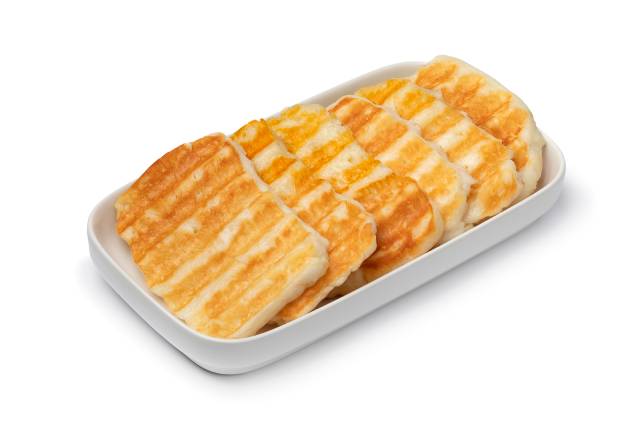
- Country of Origin: Cyprus
- Strength: Mild to strong, salty
- Texture: Chewy, firm, rubbery
- Appearance: Pale white to light yellow
- Calories: 311 kcal
- Carbohydrate: 1.7 g
- Fat: 23.5 g
- Protein: 23.9 g
Halloumi is an interesting Cypriot variety of cheese that is usually cooked prior to eating.
This is because the cheese has a high melting point, meaning that it can be fried or grilled without melting. Compared to other cheeses, Halloumi contains more sodium, so it has a somewhat salty taste.
Another unique characteristic of halloumi is that it has a somewhat rubbery texture, and feels like it is squeaking when chewed.
Most Halloumi is made from goat and sheep milk.
Over the past decade, Halloumi has vastly grown in popularity around the world, and this trend is expected to continue. In fact, the global Halloumi market has been predicted to almost double to $737 million by 2027 from $421 million in 2019.
Key Point:Halloumi is an increasingly popular cheese that originated in Cyprus. It is mostly eaten fried or grilled.
13. Havarti
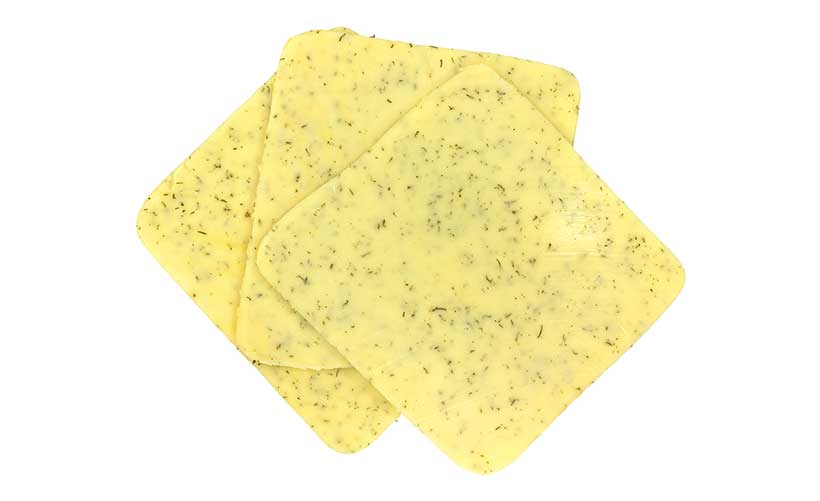
- Country of Origin: Denmark
- Strength: Mild to sharp
- Texture: Semi-soft, creamy
- Appearance: Pale yellow with "eyes"
- Calories: 393 kcal
- Carbohydrate: 3.6 g
- Fat: 32.1 g
- Protein: 21.4 g
Havarti is a semi-soft Danish table cheese.
Like all cheeses, the flavor of Havarti develops as it ages; young Havarti has a mild, buttery texture and a slightly tangy taste. In contrast, older varieties are still smooth and creamy but taste sharper with a salty and robust flavor.
However, the typical aging process of Havarti lasts for around three months.
Havarti makes a great pairing with wine, cured meat, and fruit, and many people like to grill it.
Key Point:Havarti is a soft and creamy cheese from Denmark.
14. Jarlsberg
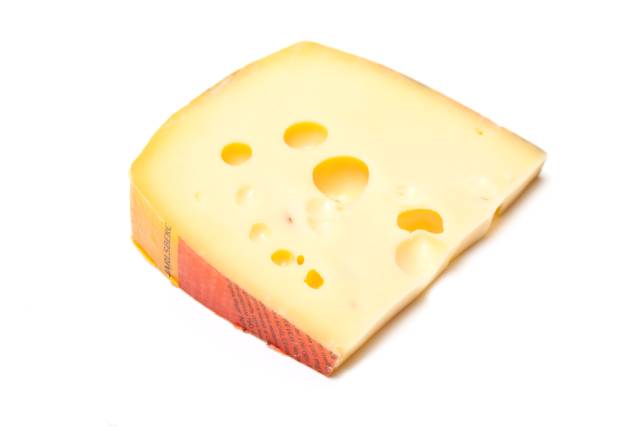
- Country of Origin: Norway
- Strength: Mild
- Texture: Semi-soft
- Appearance: Pale yellow with large holes throughout
- Calories: 351 kcal
- Carbohydrate: 0 g
- Fat: 27 g
- Protein: 27 g
Jarlsberg is a popular Norwegian cheese with a mild and nutty flavor.
The cheese has an attractive appearance thanks to its large holes throughout, and it's one of the best-tasting cheese options too.
One of the best things about Jarlsberg is the versatility of the cheese, and its texture and flavor work well in a wide range of different dishes.
Since Jarlsberg melts easily, it is often used for making fondue and cheese dip products.
Find out more about Jarlsberg in this complete guide.
Key Point:Havarti is a soft and creamy cheese from Denmark.
15. Manchego
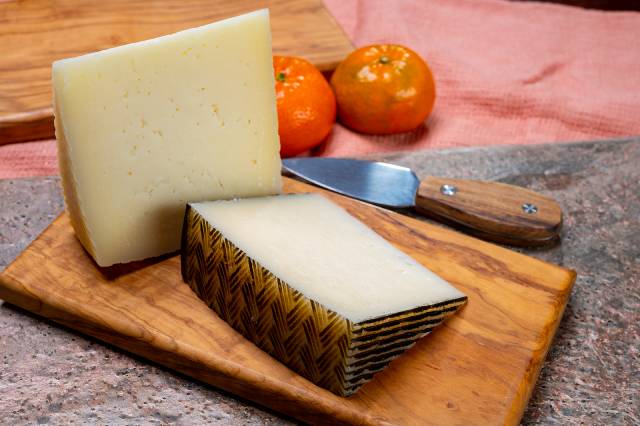
- Country of Origin: Spain
- Strength: Medium (but varies by age)
- Texture: Semi-hard
- Appearance: Pale white to yellow
- Calories: 455 kcal
- Carbohydrate: 1.9 g
- Fat: 39.0 g
- Protein: 24.0 g
Manchego is a delicious Spanish cheese made from sheep's milk. It has a soft to mildly firm texture, and it is very creamy due to its high fat content.
Although Manchego has a distinct, slightly sharp and sweet taste, it is still relatively mild and easy to eat alone.
Manchego is the most popular cheese in Spain, and its origins may go back thousands of years.
Key Point:Manchego is a delicious creamy Spanish cheese.
16. Mascarpone
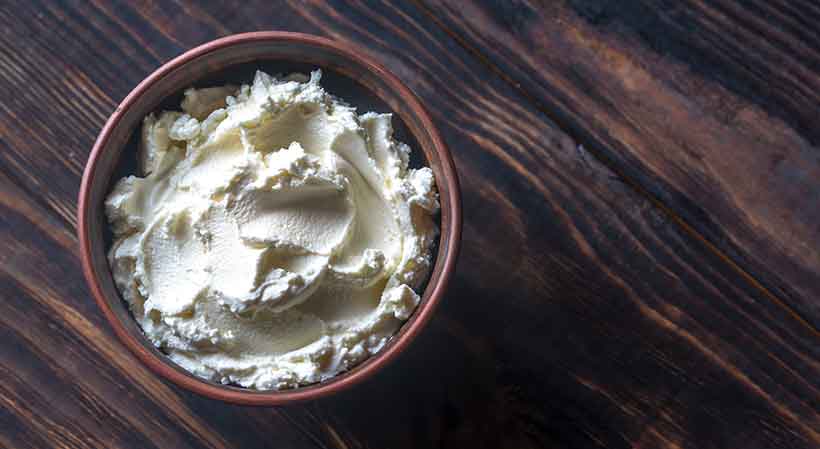
- Country of Origin: Italy
- Strength: Very mild
- Texture: Soft, creamy
- Appearance: Thick, white, creamy
- Calories: 429 kcal
- Carbohydrate: 0 g
- Fat: 46.4 g
- Protein: 7.1 g
Mascarpone is a soft cream cheese from Italy and can either be made with cow's milk or cream.
Notably, it is a fresh cheese and does not undergo fermentation,
Mascarpone has many uses, and it spreads easily like standard cream cheese.
Popular foods that use Mascarpone include the Italian dessert tiramisu and risotto, and many cheesecakes use it too.
In terms of appearance, Mascarpone is a creamy white color, and it looks similar to yogurt or a thicker version of sour cream.
Mascarpone has a delicious light, creamy and very mild taste.
Some people say it is a more flavorful version of cream, and I would say it tastes similar to clotted cream.
Key Point:Mascarpone is one of the most famous soft cheeses, and it has a light and creamy texture. People typically use it with fruits and desserts, or to thicken sauces.
17. Monterey Jack
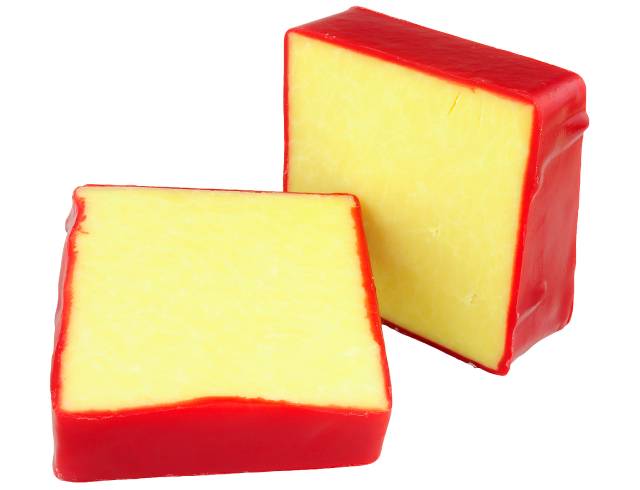
- Country of Origin: United States
- Strength: Mild
- Texture: Semi-hard
- Appearance: Creamy white to mild yellow
- Calories: 373 kcal
- Carbohydrate: 0.7 g
- Fat: 30.0 g
- Protein: 24.5 g
Monterey Jack is one of the most popular cheese options in the United States.
It has a mild flavor, a light creamy color, and it melts well, making it suitable for a range of uses.
The cheese is made from cow's milk and has a semi-hard texture.
According to the 'true story of Monterey Jack,' this famous cheese first originated in the 1700s.
Key Point:Monterey Jack is a popular mild-tasting cheese from the United States.
18. Mozzarella
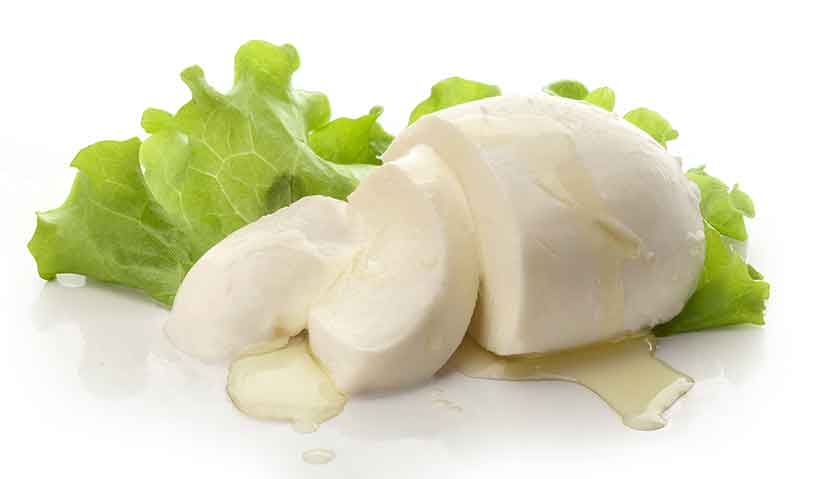
- Country of Origin: Italy
- Strength: Mild
- Texture: Soft, chewy
- Appearance: Creamy white
- Calories: 318 kcal
- Carbohydrate: 2.5 g
- Fat: 24.6 g
- Protein: 21.6 g
Mozzarella is one of the best-known cheeses in the world.
It originates from Southern Italy, and it is traditionally made from Italian Buffalo's milk. However, in recent times, Mozzarella from cow, goat, and sheep's milk is being produced.
Mozzarella comes in two main varieties; fresh and dried.
The fresh version is delicious by itself or with some olive oil and herbs. It is also a frequent ingredient in various salads.
On the contrary, dried Mozzarella is for culinary purposes; most commonly pizza, lasagna, and other baked dishes.
Key Point:Mozzarella is one of the most prevalent kinds of cheese in the world.
19. Paneer
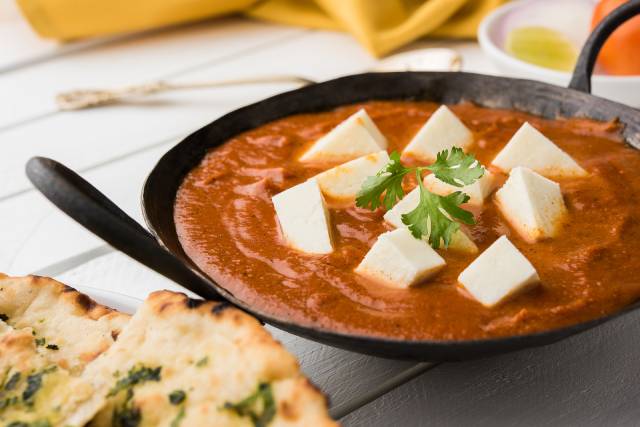
- Country of Origin: India
- Strength: Mild
- Texture: Soft, semi-firm, spongy
- Appearance: Creamy white
- Calories: 369 kcal
- Carbohydrate: 2.0 g
- Fat: 30.6 g
- Protein: 21.5 g
Paneer is a fresh variety of cheese from India usually served in small cubes.
The appearance and texture of paneer somewhat resemble tofu, particularly when used in cooked dishes.
Paneer is very similar to cottage cheese in how its made and its overall characteristics. However, paneer is not salted and it has a firmer texture.
It is also quite bland alone, which lends itself to the wide variety of recipes paneer features in. In India, paneer is often eaten after being spiced or used in curries like this one.
Key Point:Paneer is a unique fresh cheese from India with a wide variety of uses.
20. Parmigiano-Reggiano (Parmesan)
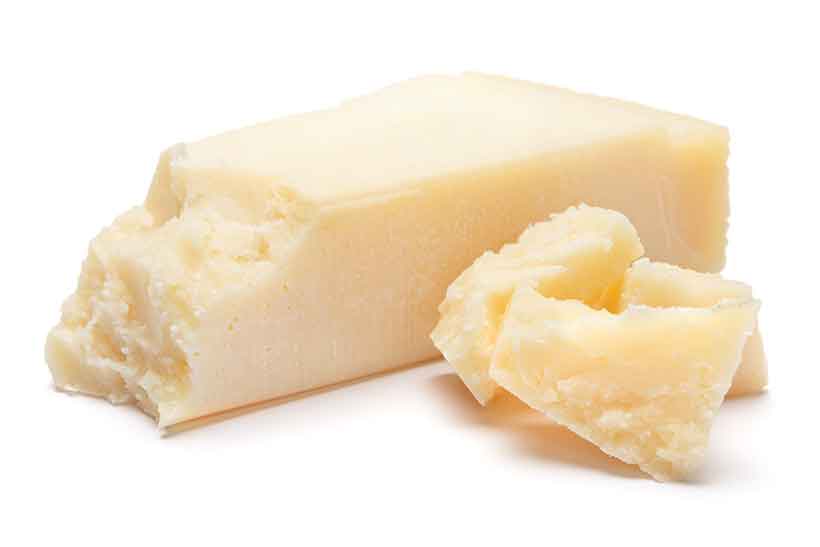
- Country of Origin: Italy
- Strength: Medium to strong (depending on age)
- Texture: Hard, crumbly, granular
- Appearance: Pale yellow
- Calories: 431 kcal
- Carbohydrate: 4.1 g
- Fat: 28.6 g
- Protein: 35.8 g
Marking the third Italian cheese in a row, Parmigiano-Reggiano is a dry, crumbly, hard cheese with a strong, robust flavor.
People often refer to the cheese as Parmesan, and it has a protected designation of origin (POD status). This designation means that the cheese can only be from its home region in Northern Italy.
Parmesan usually comes in unpasteurized form, and it undergoes an aging time of between one and three years.
Consequently, it is very rich in flavor and can be overpowering when eaten alone.
Usually, Parmesan is used as a condiment for various dishes and may come in a granular, powdery form.
Key Point:Parmesan is an Italian cheese that is most often used as a condiment, and it adds a lot of flavor to foods.
21. Pecorino Romano
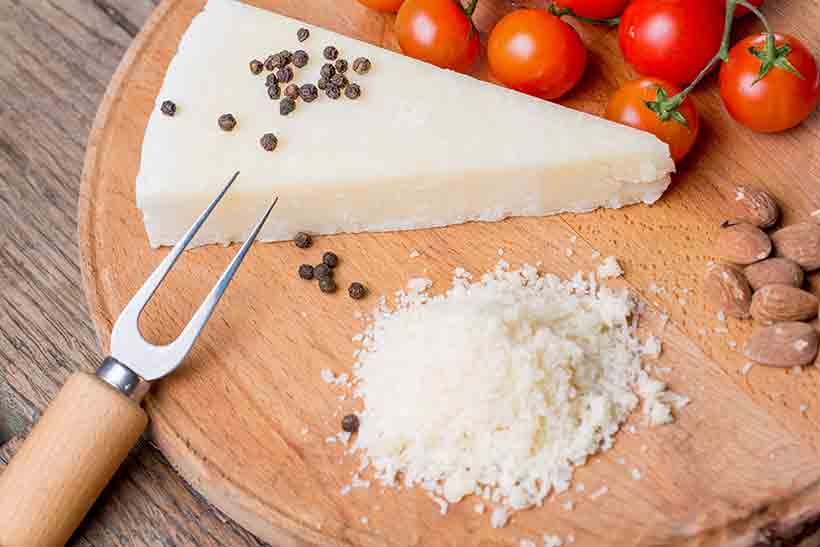
- Country of Origin: Italy
- Strength: Strong, sharp
- Texture:Hard and crumbly
- Appearance: Pale yellow
- Calories: 387 kcal
- Carbohydrate: 3.6 g
- Fat: 26.9 g
- Protein: 31.8 g
Pecorino Romano is one of the world's oldest (and favorite) cheeses, and when you taste it, it is easy to understand why.
The cheese goes back to Roman times, and it was part of the staple diet for Roman legions.
Pecorino Romano uses sheep's milk, and it is very hard and salty. It is very similar to Parmesan in appearance, but it tastes much saltier and sharper.
For those who appreciate strong flavors, Pecorino Romano is an excellent choice. However, those look for something less powerful might want to try Parmesan.
Pecorino Romano should not be confused with generic 'Romano' cheeses in the North Americas. These cheeses use cow's milk and are much milder in intensity.
Key Point:Romano dates back to the Roman empire, and it is still one of the world's most popular cheese options.
22. Provolone
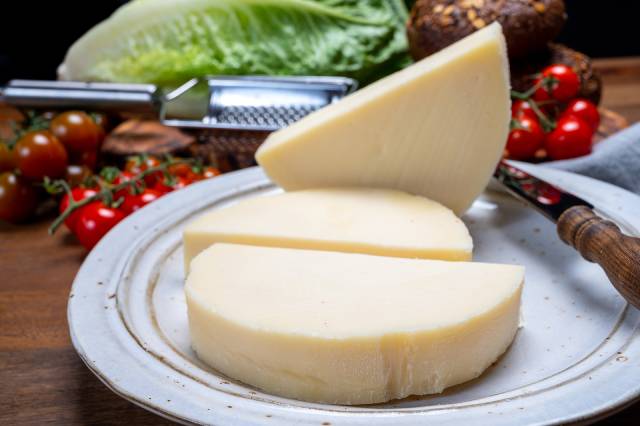
- Country of Origin: Italy
- Strength: Medium (varies by age)
- Texture:Semi-hard
- Appearance: Creamy in color
- Calories: 351 kcal
- Carbohydrate: 2.1 g
- Fat: 26.6 g
- Protein: 25.6 g
Provolone is a popular Italian cheese that can vary in flavor from mild and light to strong and sharp, depending on the production and aging time.
The cheese originated in Southern Italy in the 1800s and it is made with cow's milk.
It is also possible to buy smoked provolone cheese, which has an extra rich and smoky flavor.
Key Point:Provolone is one of the most famous Italian cheeses, and it is available in smoked and unsmoked varieties.
23. Ricotta
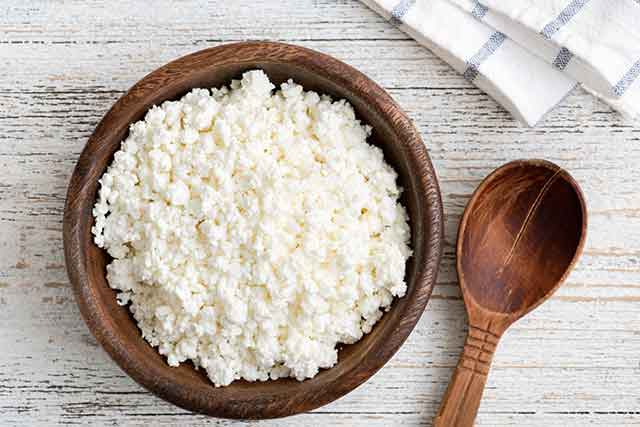
- Country of Origin: Italy
- Strength: Mild, slightly sweet
- Texture:Soft, creamy
- Appearance: Curds, white/light cream color
- Calories: 174 kcal
- Carbohydrate: 3.0 g
- Fat: 13.0 g
- Protein: 11.3 g
Ricotta is a soft fresh Italian cheese made from whey.
This cheese has a mild, slightly sweet, and creamy texture, and it is one of the most popular types of cheese in the world.
Ricotta has some excellent nutritional benefits too. For one thing, it is lower in calories than most other cheese options and it is an excellent source of protein.
Low-fat versions of ricotta are also available, and these are very popular with athletes and bodybuilders due to their impressive protein-density.
For a detailed review, see this guide to the nutrition benefits of ricotta.
24. Roquefort
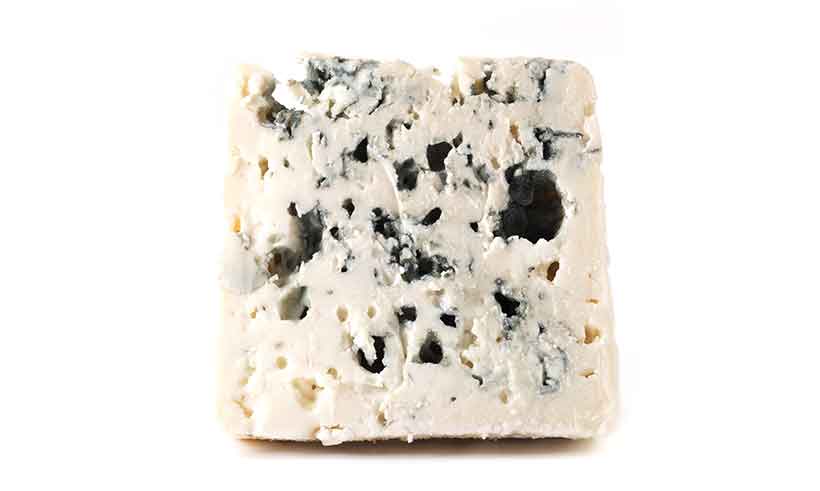
- Country of Origin: France
- Strength: Strong, tangy
- Texture:Semi-hard, crumbly
- Appearance: White with large blue veins
- Calories: 369 kcal
- Carbohydrate: 2 g
- Fat: 30.6 g
- Protein: 21.5 g
Roquefort is the French entry into the world of blue cheese, and it is known locally as the 'king of cheese'.
Roquefort comes from sheep's milk and it is ripened in the caves of Roquefort-sur-Soulzon, Southern France.
Reportedly, these caves contain a particular type of bacteria in their soil, which gives Roquefort (and other blue cheeses) some unique characteristics.
This bacteria is known as Penicillium roqueforti, and studies suggest that it may help to guard against cardiovascular disease.
Producers typically age Roquefort for around five months, and it has a sharp, tangy flavor.
Key Point:Roquefort is a delicious and flavorful soft blue cheese from France.
25. Stilton
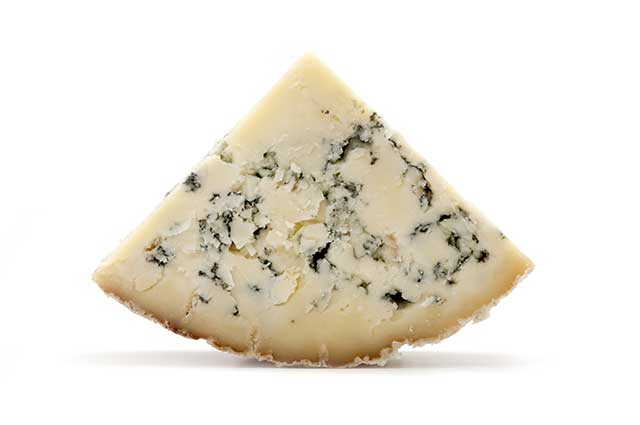
- Country of Origin: England
- Strength: Medium-Strong
- Texture:Semi-soft
- Appearance: Creamy yellow with small blue veins running out from the center
- Calories: 393 kcal
- Carbohydrate: 3.6 g
- Fat: 35.7 g
- Protein: 25.0 g
Blue Stilton is one of the most famous types of cheese from England, and producers now export it around the world.
Stilton has a long and rich history too, and it has played a part in the English diet since the early 18th century.
While the cheese is quite strong and flavorful, it isn't quite as sharp as other blue cheese varieties, and it has a more mellow taste.
The cheese has some interesting nutrition benefits too, and it is an excellent source of vitamin K2.
See this full guide to Stilton for more information.
Key Point:Stilton is a traditional and very flavorful British cheese that enjoys a lot of popularity in its homeland.
26. String Cheese
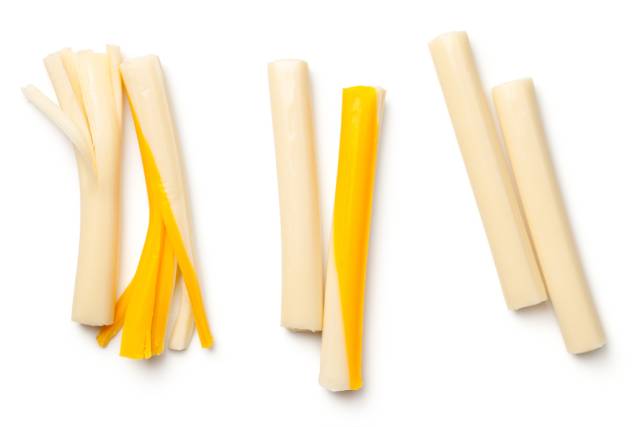
- Country of Origin: United States
- Strength: Mild
- Texture:Soft, chewy
- Appearance: Light cream to orange
- Calories: 295 kcal
- Carbohydrate: 5.6 g
- Fat: 19.8 g
- Protein: 23.8 g
Similar to other cheese products like cream cheese, string cheese undergoes greater processing than regular cheese.
However, the extent of processing doesn't always influence the respective health properties of food.
In the case of string cheese, it is very similar nutritionally to regular cheese.
The minimal manufacturing process requires only heat treatment and no extra ingredients.
String cheese usually comes from mozzarella cheese, and there is a full guide to string cheese here.
Key Point:String cheese is a popular processed cheese product originating in the United States.
27. Wensleydale
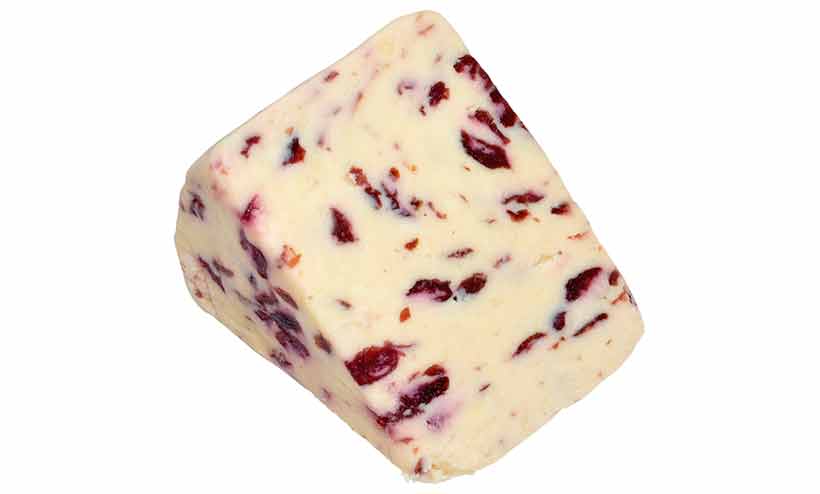
- Country of Origin: England
- Strength: Mild
- Texture:Moist, crumbly
- Appearance: Pale and crumbly
- Calories: 385 kcal
- Carbohydrate: 0.1 g
- Fat: 31.8 g
- Protein: 23.7 g
Wensleydale is a famous British cheese that is originally from the village of Wensleydale in North Yorkshire, England.
Wensleydale has a white to pale-yellow appearance, and it is a crumbly cheese.
The flavor is somewhat tart, hence is it sometimes combined with fruit, especially cranberries and apricots.
Although it is available in white and blue versions, white Wensleydale is far more prevalent these days.
Key Point:Wensleydale is a popular British cheese and it often contains dried fruit.
What is the Best Cheese?
The "best cheese" is very subjective and depends on the individual.
However, all cheese is nutritionally beneficial and contains a wide range of nutrients.
In short; the "best cheese" is simply the one you enjoy the most.
Related Articles
Cheese: Good or Bad? An Evidence-Based Guide
30 High-Protein Cheeses: Which Offer the Most?
Types of Cheese You Can Put on Pizza
Source: https://www.nutritionadvance.com/types-of-cheese/